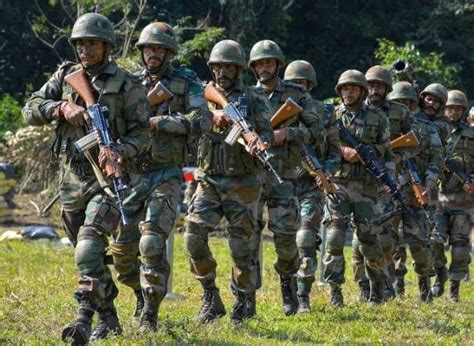
Pic Credit: thefederal.com Army deployed in Nagaland
Maj Gen S.G.Vombatkere ADG DV (1994-1996)
Public opinion, especially of the literate and opinion-influencing public, is heavily influenced by print and electronic media. The army is pleased to think that public opinion, again particularly of the literate and opinion-influencing public, regarding the army is largely favourable, because of the numerous and frequent instances when it is called upon to render national service, which the civil administration is unwilling, unable or incompetent to perform with the police resources at its command. Instances of the army (and to a lesser extent the navy and air force) rendering national service “in aid of the civil power” (defined in the Constitution of India, Article 246) is relief and rescue in natural and man-made calamities and accidents (including rescuing children from borewells), all carried out with characteristic elan and discipline. But there is one aspect of the army’s activities which has drawn flak from the public, and that is the instances of HR violations committed by army personnel on IS duties.
We in the serving and Veteran fraternity know that instances of CI ops-related HR violations are investigated and disciplinary action is taken against the accused, and that often administrative action is also taken against the command structure. But there are inevitably slippages and even cover-ups in the system. These attract extremely negative media attention and cause adverse public opinion about the army that effectively negates the public appreciation won elsewhere at great cost. But most importantly, the media coverage of the army’s slip-ups and cover-ups is focused on showing that the AFSPA provides impunity and even enables and encourages army personnel to carry out rape, molestation etc., and that AFSPA exists because the army wants it.
There are some sources of confusion that the scheming, anti-army bureaucracy/police (especially in MoD and MoH) deliberately omits to bring out, and which the media obediently or conveniently omits to question: One, the public confusion over distinguishing between the army and central police forces, and the term “armed forces” incorrectly (actually unconstitutionally – see Article 33(A)) being used to include armed para-military forces. Thus, crimes committed by BSF, CRPF etc., are attributed to the army because civilians are ignorant of army ranks and uniform, and also because the police use olive-green and disruptive pattern uniforms that are similar to or identical with army uniforms. Two, the army cannot open fire on civilians without the express written permission of civil authority (magistrate), and AFSPA is applicable ONLY in areas defined by civil government as “disturbed” and ONLY when civil government calls in the army to maintain law and order, after civil administration (including the state and central police) has failed in its primary duty of maintaining law and order. Three, it is continued failure of governance (the primary responsibility of the elected politician and appointed bureaucrat) due to incompetence, corruption, ignorance, etc., that has created continuous or continual law and order including insurgency situations of “disturbed areas”, necessitating calling upon the army “in aid of the civil power” continuously for decades.
The fact is, as we all know, government (and not the army) invokes AFSPA so that army units and formations deployed on IS duties will have legal cover. Without AFSPA, every round fired by the army would be illegal and potentially an attempt to murder. Yet, taking only one most recent cue from an editorial in “The Hindu” of 23 August 2014, on the re-arrest of Irom Sharmila (who has been on fast for over 11 years in protest against AFSPA), it rather casually states, “The ‘Iron Lady of Manipur’ has come to symbolise the conscience of a country that probably recognises that AFSPA gives unconscionable protection to excesses committed by the Army in parts of India hit by political conflict, but is unable to abrogate, amend or dilute it. The state has been unable or unwilling to prevail over the Army, which stubbornly favours the retention of the indefensible law.”
We in the serving and Veteran fraternity understand that the army has no institutional stake in carrying out or continuing in its secondary role of aid of the civil power for IS duties or rescue/relief duties. But this is not known to the media or the public, and the quote above demonstrates this. This writer learns that ADG PI has made public statements to that effect. But the media persists in declaring that the army “stubbornly favours the retention of the indefensible law”, and public opinion about the army is influenced by the devious machinations of the bureaucracy.
It is therefore the considered view of this writer that COAS needs to address a press conference specifically on AFSPA at least once during his tenure. Further, that PSOs need to address periodic press briefings/conferences (this suggestion for bi-annual conferences was placed on file to COAS and VCOAS by this writer when he was ADG DV in 1994-1996) covering their areas of command and control. In these briefings/conferences, the AG would cover the issues of discipline including those concerning HR violations by army personnel during IS duties, the MGO might cover the issues of weapons and equipment acquisitions, the QMG might cover matters of defense land and accommodation authorization, and so on with other PSOs. Naturally, the PSOs would prepare for answering probing, awkward and contentious questions. This writer strongly feels that such exposure to public gaze should be a part and parcel of PSOs charter of duties, if the army is to get a fair deal. (When this writer was ADG DV, with the concurrence of COAS – then Gen Shankar Roychowdhury – he addressed two press conferences on HR violations by army personnel, and the journalists present asked why this was not being done more frequently).
The army’s image needs to be built up in the public view, and public opinion will have its effect upon the political class whose opinion is presently influenced principally by the bureaucracy. COAS and PSOs addressing the media and taking on questions (as suggested above), can get the army and its role into the minds of the political class, past the hurdles cunningly placed by bureaucrats and police officials to keep the army insulated from the political leadership and under civil service control instead of under civil cabinet control.
This writer has published a number of articles and given interviews over the last few years, bringing out the facts and inconsistencies concerning AFSPA (ATTACHED herewith for information). But the Veteran fraternity has not taken it up for discussion, perhaps because of being narrowly focussed on OROP. Also, copies endorsed to Army HQ have also drawn no response, while senior officers who appear on TV have never stated the position clearly. Hopefully this Note will draw at least an acknowledgement and spark an in-house debate concerning how the army should project its image, beyond TV advertisements, to motivate youth to join the officer cadre.
